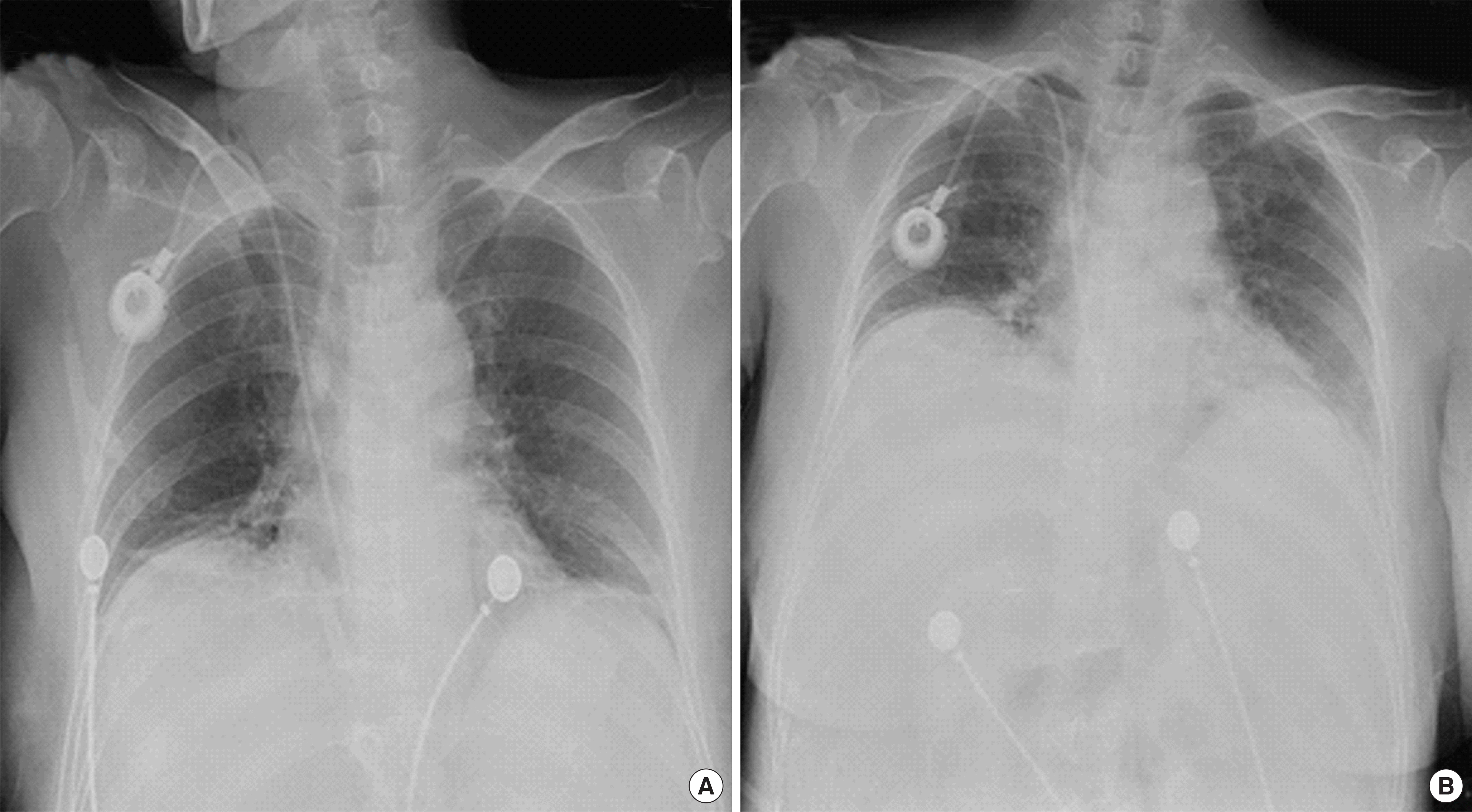Abstract
Transfusion-associated circulatory overload (TACO) is recently becoming more important than transfusion-related acute lung injury (TRALI) in terms of the number of patients with definite diagnosis as well as its prognosis. In order to diagnose TACO, it is helpful to recognize early the symptoms suspicious of transfusion reaction through electronic medical record system and computer network, and this will be of help for obtaining samples for brain natriuretic peptide (BNP) measurement before and after the onset of transfusion reaction. We report a case in which a transfusion reaction was diagnosed as TACO. A 62-year-old woman was admitted to the emergency room due to bleeding tendency. Two fresh frozen plasma units and one unit of leukocyte-reduced red blood cells were transfused. Blood pressure increased during transfusion, and the chest X-ray showed findings suggestive of newly developed pulmonary edema. N-terminal prohormone of BNP (NT-proBNP) test was carried out using the specimens in refrigerated storage. Compared with the NT-proBNP level measured 12 hours before the transfusion, that measured 6 hours after the transfusion was markedly increased (>48 fold of pre-transfusion level). As a result, this case was diagnosed with TACO.
Go to : 
REFERENCES
1.Sanders RP., Geiger TL., Heddle N., Pui CH., Howard SC. A revised clas-sifcation scheme for acute transfusion reactions. Transfusion. 2007. 47:621–8.
3.Bolton-Maggs PH. SHOT conference report 2016: serious hazards of transfusion - human factors continue to cause most transfusion-related incidents. Transfus Med. 2016. 26:401–5.
4.Cho J., Choi SJ., Kim S., Alghamdi E., Kim HO. Frequency and pattern of noninfectious adverse transfusion reactions at a tertiary care hospital in Korea. Ann Lab Med. 2016. 36:36–41.

5.HanK-S. Park KU, et al. Transfusion Medicine. 4th ed.Seoul: Korea Medical Book Publishing Company;2014. p. 298–300.
6.Ahn K., Kim J., Kim Y., Uh Y., Hyun S., Lee J. Reporting system of transfusion adverse reaction using electronic medical records Data. Korean J Blood Transfus. 2015. 26:152–8.

7.Andrzejewski C., Escoval MA., Bolton-Maggs P., Grey S., Land K., Lucero H, et al. Transfusion-associated circulatory overload (TACO) Draft revised reporting criteria. http://www.isbtweb.org/fleadmin/user_up-load/Working_parties/WP_on_Haemovigilance/TACO_reporting_cri-teria_draft_Nov_2016.pdf(UpdatedonJanuary2017).
8.Zhou L., Giacherio D., Cooling L., Davenport RD. Use of B-natriuretic peptide as a diagnostic marker in the differential diagnosis of transfusion-associated circulatory overload. Transfusion. 2005. 45:1056–63.

9.Tobian AA., Sokoll LJ., Tisch DJ., Ness PM., Shan H. N-terminal pro-brain natriuretic peptide is a useful diagnostic marker for transfusion-associated circulatory overload. Transfusion. 2008. 48:1143–50.

10.Januzzi JL., van Kimmenade R., Lainchbury J., Bayes-Genis A., Ordonez-Llanos J., Santalo-Bel M, et al. NT-proBNP testing for diagnosis and short-term prognosis in acute destabilized heart failure: an international pooled analysis of 1256 patients: the International Collaborative of NT-proBNP Study. Eur Heart J. 2006. 27:330–7.
11.Downie PF., Talwar S., Squire IB., Davies JE., Barnett DB., Ng LL. Assessment of the stability of N-terminal pro-brain natriuretic peptide in vi-tro: implications for assessment of left ventricular dysfunction. Clin Sci (Lond). 1999. 97:255–8.

12.Dasgupta A., Chow L., Tso G., Nazareno L. Stability of NT-proBNP in serum specimens collected in Becton Dickinson Vacutainer (SST) tubes. Clin Chem. 2003. 49:958–60.

13.Fatalities Reported to FDA Following Blood Collection and Transfusion Annual Summary. https://www.fda.gov/BiologicsBloodVaccines/SafetyAvailability/ReportaProblem/TransfusionDonationFatalities/de-fault.htm. (Updated on January 2018).
14.Annual Report of the Korea Blood Safety Commission (KBSC) Performance. http://www.kohevis.or.kr/sub/catalog.php?CatNo=19. (Updated on July 2017).
Go to : 
 | Fig. 1.Changes in chest X-ray before (A) and after (B) transfusion. Mild haziness in both lung fields was newly developed, suggesting pulmonary edema. |
Table 1.
Intake and output after the onset of transfusion-associated adverse reactions
| Intake and output | Before diuretics injection∗ | After diuretics injection† |
|---|---|---|
| Total intake (mL) | 1,742 | 795 |
| Oral (mL) | 20 | 0 |
| IVF (mL) | 430 | 270 |
| Blood (mL) | 1,292 | 525 |
| Total output (mL) | 225 | 590 |
| Urine (mL) | 225 | 590 |
| Feces (number) | 1 | 0 |
| Drainage (mL) | 0 | 0 |
Table 2.
Changes in laboratory findings
| Laboratory variables | Before transfusion | After transfusion | After 7 days |
|---|---|---|---|
| NT-proBNP∗ (pg/mL) | 20.03 | 971.70 | - |
| SO2 (%) | 98.5 | 92.6 | - |
| Intake/output (mL) | 720/125 | 1,742/225 | 1,200/1,430 |
| SBP/DBP (mmHg) | 105/72 | 165/97 | 130/81 |
| WBC (109/L) | 9.91 | 20.9 | 8.7 |
| Hb (g/dL) | 6.5 | 9.1 | 9.4 |
| Hct (%) | 20.3 | 27.7 | 30 |
| Platelet (109/L) | 56 | 28 | 39 |
| PT (sec) | 18.5 | 21.5 | 17.3 |
| PT (INR) | 1.65 | 1.93 | 1.54 |
| aPTT (sec) | 34.8 | 35.7 | 31.5 |
| BUN (mg/dL) | 8.6 | 12.6 | 21.8 |
| Creatinine (mg/dL) | 0.47 | 1.29 | 0.42 |
∗ NT-proBNP level measured 6 hours after the initiation of blood transfusion was higher than that measured 12 hours before the initiation of transfusion. Abbreviations: aPTT, activated partial thromboplastin time; BUN, blood urea nitrogen; SBP, systolic blood pressure; DBP, diastolic blood pressure; Hb, hemoglobin; Hct, hematocrit; NT-proBNP, N-terminal prohormone of brain natriuretic peptide; PT, prothrombin time; SO2, oxygen saturation; WBC, white blood cell.




 PDF
PDF ePub
ePub Citation
Citation Print
Print


 XML Download
XML Download